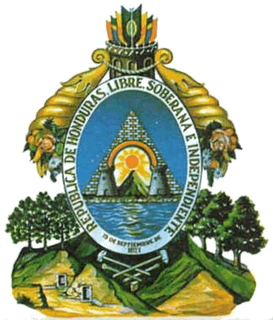 |
| Honduran national emblem |
Many Hondurans believe that Honduras’ Independence Day is on September 15, 1821. In fact, September 15th is a Honduran national holiday, and this date is at the foot of the national emblem surrounded by the Legend: Republic of Honduras, Free, Sovereign and Independent.
However, this is not correct.
Honduras did not come to life as an independent country, but as State that was part of the Central American Federation.
Another group of more informed Hondurans would tell us that September 15, 1821 is the date on which Central America proclaimed its independence from Spain, but this is also mistaken.
The famous “Declaration of Independence” of September 15, 1821 doesn’t even establish the Independence of Central America, but postpones the decision on this issue, delegating it to a Congress that that would meet in March 1822. That Congress never met.
In fact, the Bill of Independence of September 15, 1821 was just an aristocratic maneuver made to prevent an Independence with revolutionary scopes. The Bill of September 15th sought to maintain the colonial regime, with the same authorities that now wouldn’t be accountable before Spain.
Independence was only taken into consideration by the local elite of Spanish descent as measure of last resort to “prevent the terrible consequences that would follow in case the people itself proclaims it” as says the same declaration drafted -but not signed— by Jose Cecilio del Valle, considered as a national hero in Honduras.
This exposes the falsity of the claim found in the Honduran national anthem, the lyrics of which were written by Augusto C. Coello. A stanza of said anthem compares what happened on 15 September 1821 with the French Revolution.
The truth is that September 15, 1821 is not a glorious date of national liberation, but a date on which the expectations of the Patriots were betrayed and democracy was trampled, because the aristocracy immediately maneuvered to attach Central America to Iturbide’s Mexican Empire, in order to maintain their privileges threatened by a democratic and republican revolution. This annexation was declared on January 5, 1822.
The annexation bill to Mexico was drafted —and this time signed— by Jose Cecilio del Valle, which is held as a great hero in Honduras. And yet it was under the influence of Valle on the Mexican Congress that Central America won its independence from Mexico, Independence that was proclaimed officially on July 1, 1823 by the Central American Constituent Assembly.
The Constituent Assembly decided that the system of government of Central America would be republican and federal, granting autonomy to each of the five States that comprised it: Guatemala, El Salvador, Honduras, Nicaragua and Costa Rica.
Under this Constitution Manuel Jose Arce was elected as Central America’s first president on March 5, 1824, and on 16 September, 1824 Dionisio de Herrera was elected as the first Chief of State of Honduras.
But the Central American Federation was unable to consolidate under the strong opposition of conservatives, who wanted to preserve the oppressive system of privileges of the Spanish Colonization.
Upon Gen. Francisco Morazan fell the task of fighting against the anti-democratic reaction, which found a strong ally in Catholic obscurantism, but the proportion of forces didn’t favored him, and Morazan had to pay with his life the audacity to dream with the Great Central American Motherland. Morazan was executed by firing squad on September 15, 1842 in Costa Rica.
With the death of Morazan the conservative reaction triumphed, and the dream of a Central American Federation was truncated. But Honduras had already been declared independent of the Central American Federation on October 26, 1838. This date was of no glory to Honduras, it was a historical setback that sunk the Honduran government in a strong anti-Morazanic reaction in the hands of president Francisco Ferrera.
The democratic and republican ideal just begun timidly on 1876 in Honduras in the so called “Liberal Reform”, led by president Marco Aurelio Soto and his minister and advisor Ramon Rosa.
Then followed fifty years of fratricidal wars, ending in the 16-year dictatorship of Tiburcio Carias Andino. Carias ruled from 1933 to 1949.
Carias finally manages to put an end to civil wars and insurgent movements, with the downside of a high social cost, for the brutal repression that was unleashed against the enemies of the regime.
Carias administration’s repression achieved the consolidation of the Honduran State, but this consolidation was accompanied by subordination of the interests of Honduras to the U.S banana companies. The influence of the United States never allowed the Honduran State to be truly independent.
Gradually the Honduran people have been conquering more and more spaces of democratic freedom, but the cancer of internal corruption and the dependence on foreign aid is still an affront to the national dignity.
Honduras Independence, therefore, is not an epic event that happened in the past, as taught in Honduran formal education, but it is something that Honduras has been achieving with difficulty, and it’s still a project to be carried out.
If you want to know more about Honduran and Central American history you can order the book Understanding Central America: Global Forces, Rebellion, and Change on Amazon.
Source for this article: “Evolución histórica de Honduras”, by Longino Becerra. Baktun Editorial.